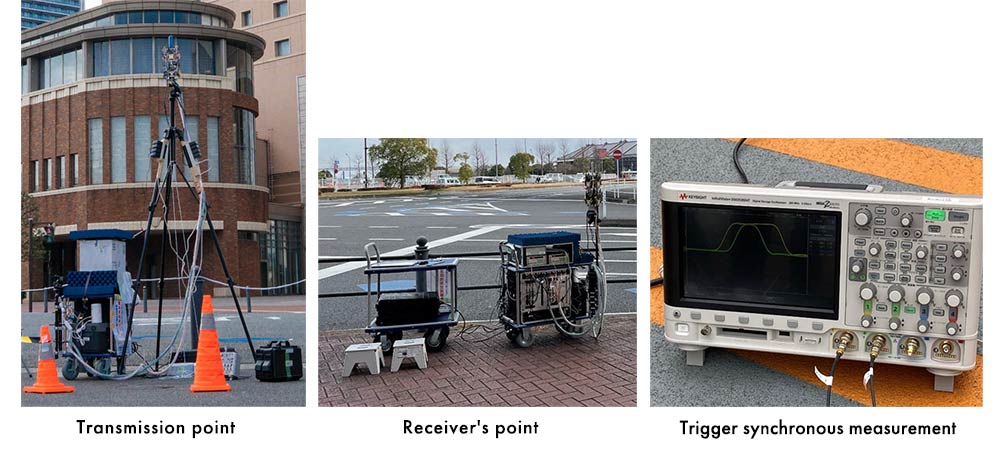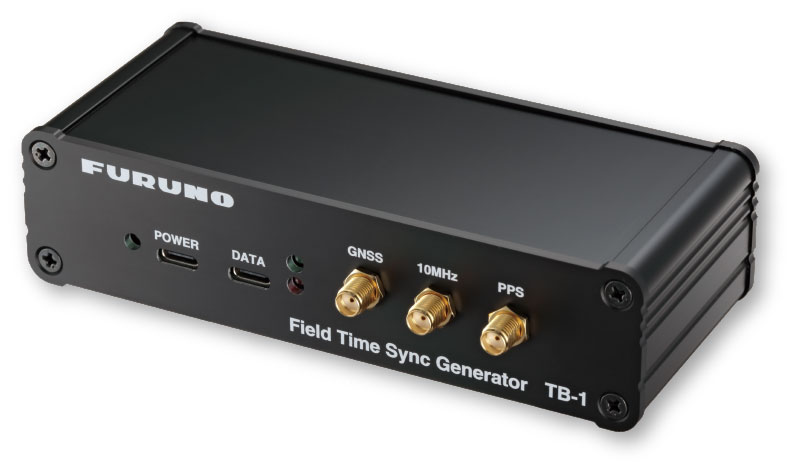Case Studies
Outdoor Time Synchronization: Measurement of Radio Propagation in Outdoor Mobile Communication Environment (Niigata University)

Time synchronization of devices at two remote locations.
TB-1 used for field verification of 6G mobile communication system
Associate Professor Minseok Kim of Niigata University (at the time of the interview in March 2022) is working on his research theme of radio propagation measurements in outdoor mobile communication environments. He was selected for a research and development project by the Ministry of Internal Affairs and Communications (commonly known as "National Project") and is contributing to the development of next-generation mobile communication systems.
Furuno’s TB-1 Field Time Sync Generator was used to generate a precise one-second pulse synchronized to UTC between two remote locations, for the research and field test of 6G mobile base stations and mobile terminals.
Background (problem)
In mobile communications research, devices that simulate mobile base stations and mobile terminals must be time synchronized for evaluation. In the laboratory environment, the signal from one rubidium oscillator can be distributed to each device, so that they are synchronized with the same reference signal.
However, for field evaluation such as outdoor environments, it is necessary to synchronize mobile base stations and mobile terminals in different locations.
In field evaluations, the signal from a single rubidium oscillator cannot be distributed due to the long distance between sites. In addition, using rubidium oscillators at each location cannot provide the accurate synchronized signals because they are independent to each other.
Cesium oscillators, which are more accurate than rubidium oscillators, were considered, but they are too expensive and difficult to transport.
This led to the adoption of the TB-1 Field Time Sync Generator at each location, which provides the same time synchronization source between two remote sites.

Time synchronization in the laboratory(Synchronized by one rubidium oscillator signal because distance between the base station and the terminal is short.)

In remote outdoor locations, if individual rubidium oscillators are used, the timing of rubidium oscillators will be different from each other.
Solution
To synchronize the signal from rubidium oscillators (FS725) that will be used in mobile base station and mobile terminals, a high-precision time signal (1 second pulse synchronized to UTC) generated by TB-1 is applied to each rubidium as a reference signal. We confirmed that the rubidium oscillators can be synchronized with high precision using this method.

Even between remote outdoor locations, rubidium oscillators are synchronized to each other with high precision through TB-1.

Synchronization between rubidium oscillators was confirmed in the laboratory. (Right photo : GNSS antenna was attached to the window)
Field Evaluation
After confirming the synchronization of rubidium in the laboratory, a field evaluation was conducted in the area around Kannai Station in Yokohama. TB-1 enabled us to measure the radio propagation characteristics in the actual use environment.

Field Evaluation
Comments by Associate Professor Minseok Kim
With the trend of Beyond 5G, automated driving, drones, IoT, etc, new wireless systems are required to be developed and deployed flexibly and quickly. This "Research and Development for Advancement of Radio Simulation System Technology in Virtual Space (2020-2023) (JPJ000254)" is a research and development project for expanding radio resources by the Ministry of Internal Affairs and Communications. We are aiming to develop a radio wave simulation system that simulates communication systems and radio wave propagation characteristics of wireless systems with high accuracy in virtual space, where we could conduct evaluation in real time.
In this project, Mr. Kim's team is in charge of research and development of a radio propagation model with good scenario applicability, that can simulate radio communications in a virtual space. They will also measure radio propagation characteristics and channel modeling in real environments.
In this R&D, field measurements of radio propagation characteristics are very important, and highly synchronized reference signals between transmitter and receiver are essential to ensure the accuracy of the propagation channel measurements. Thanks to TB-1, we are able to achieve signal synchronization with high precision. As a result, we succeeded in measuring the millimeter wave band (24 GHz and 60 GHz), which is expected to be the frequency for 5G and Beyond 5G, in the area around Yokohama Kannai Station.
Such an experiment is rare in the world, and we expect that the analysis of the measurement data would be very valuable to the researchers. We would like to thank Furuno for the technical support in our research.
Related Products
List of Case Studies
-
Automated emergency response systems (eCall / ERA-GLONASS)

-
Smart grid and GPS/GNSS timing solutions

-
Grand Master Clock and GPS/GNSS timing solutions

-
GT in Pmod™ module (NetTimeLogic)NEW

-
Outdoor Time Synchronization: Measurement of Radio Propagation in Outdoor Mobile Communication Environment (Niigata University)

-
Time Synchronization Between Radio Telescopes: Toward Observing Radio Waves from Exoplanets (Tohoku University)NEW

-
Community broadcasting Synchronization [Multi-GNSS Disciplined Oscillator]

-
FURUNO Timing and Synchronization technology adopted base stations for Digital Terrestrial Television Broadcasting

-
FURUNO Timing and Synchronization technology adopted base station for mobile telecommunications

-
FURUNO Timing and Synchronization technology adopted for seismometer


